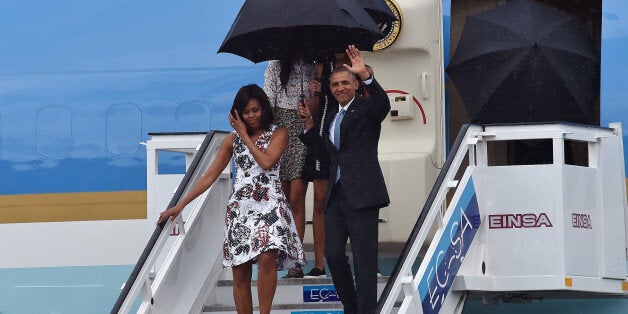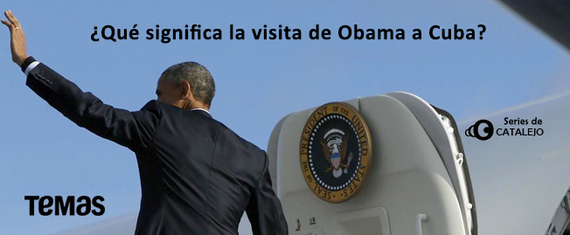
This article was written originally for the Cuban journal Revista Temas as part of the symposium, "¿Qué significa la visita de Obama a Cuba?" and it appears here with permission.
President Barack Obama's trip to Cuba will be remembered as an historic event, equal in importance to President Richard Nixon's trip to China in 1972. Like Nixon's trip, Obama's visit is a dramatic symbol of the fundamental shift away from a U.S. policy of hostility, isolation, and regime change to a policy of engagement aimed at achieving normal relations.
Obama's decision to visit Cuba and his reception by President Raúl Castro demonstrates that the two presidents intend to make improving relations a priority in the coming year. If it goes well, the visit will accelerate progress on a range of issues that are currently under discussion, facilitate new agreements on issues of mutual interest, and reduce the obstacles on both sides that are limiting commercial relations.
The biggest hurdle to fully normal relations is the continuing U.S. economic embargo. In the 15 months since December 17, 2014, President Obama has licensed significant exceptions to the embargo, opening the door for more U.S. residents to travel to Cuba and more U.S. businesses to trade with Cuban enterprises. But the core of the embargo remains in place: Cuban state enterprises cannot export to the United States and most U.S. businesses cannot invest in Cuba or become joint enterprise partners with Cuban firms.
Since lifting the entire embargo requires that Congress repeal the 1996 Helms-Burton law (the Cuban Liberty and Democratic Solidarity Act), the embargo will not be lifted during Obama's remaining time in office. In the middle of a heated presidential election campaign, Republicans controlling both the House of Representatives and the Senate will not take any action that makes Obama's policy look like a success.
The second biggest obstacle to fully normal relations is the U.S. base at Guantánamo. The United States recognizes Guantánamo as sovereign Cuban territory, but it nevertheless refuses to return the base to Cuban control. For the foreseeable future, the top issue on the U.S. agenda regarding Guantánamo will not be how to return it to Cuba, but rather how to close the detention center that Obama pledged to close when he was elected. That has to come first.
In addition, there are a great many other issues on which the two governments still disagree, ranging from migration to property claims, fugitives, TV and Radio Martí, U.S. "democracy promotion" programs, and human rights. Negotiations are currently underway on a number of these issues, but resolving them will take time -- more time than President Obama has left in office.
Therefore, Obama's goal is to make as much progress as possible in the months he has remaining so that the next president, whether Democrat or Republican, will recognize that the opening to Cuba has produced results that serve U.S. interests and should be continued. He is also trying to create stakeholders -- constituencies in U.S. society who have a stake in continuing his policy, so that it would be politically difficult for his successor to reverse it. But to succeed, he needs Cuba's cooperation, especially on the commercial front. The more contracts that major U.S. corporations sign with Cuba in the next ten months, the more momentum there will be to lift the embargo in 2017 and the harder it will be for opponents of the new relationship to roll back the progress that has been made. It is not a coincidence that a number of senior U.S. corporate executives are going to Cuba with Obama, as is Secretary of Commerce Penny Pritzker, who has been at the forefront of trying to remove obstacles to economic engagement. Obama will undoubtedly raise the sensitive issue of human rights in his meetings with President Raúl Castro, just as he has in their prior meetings. He will undoubtedly speak eloquently of the virtues of human rights and democracy in his address to the Cuban people. And he will meet with a broad cross-section of representatives from Cuban civil society, including prominent dissidents, just as Secretary of State John Kerry did when he celebrated the reopening of the U.S. Embassy last year. Normalization does not mean that disagreements between the United States and Cuba will disappear. It means that they can be discussed in an atmosphere of mutual respect and civility.Obama's critics have argued that the trip is coming too early in the normalization process, that not enough has been achieved to justify a presidential visit. But for Obama's purposes, the trip is well timed. By going now, he gives his administration ten months to work on turning the momentum of the presidential visit into concrete agreements. If Obama waited until the fall, the trip would be a nice photo-opportunity, but the administration would not have time to turn it into real progress.President Obama's trip to Cuba will not resolve the many disagreements that remain between Cuba and the United States, of course. No one should expect that the legacy of half a century of hostility can be erased so easily. Rather, the trip's success should be judged by whether it advances the broad process of normalization, especially in areas where U.S. and Cuban interest coincide -- in fields like commerce, global public health, environmental protection and the fight against narcotics trafficking. Each time the two president's meet and talk candidly with one another about not only points of disagreement but mutual interests, they bring us closer to the day when relations between Cuba and the United States will, for the first time in history, be truly normal.
William M. LeoGrande is Professor of Government in the School of Public Affairs at American University in Washington, DC and coauthor with Peter Kornbluh of Back Channel to Cuba: The Hidden History of Negotiations between Washington and Havana (University of North Carolina Press, 2015), available in Spanish as Diplomacia encubierta con Cuba: Historia de las negociaciones secretas entre Washington y La Habana (Fondo de Cultura Económico, 2015).
